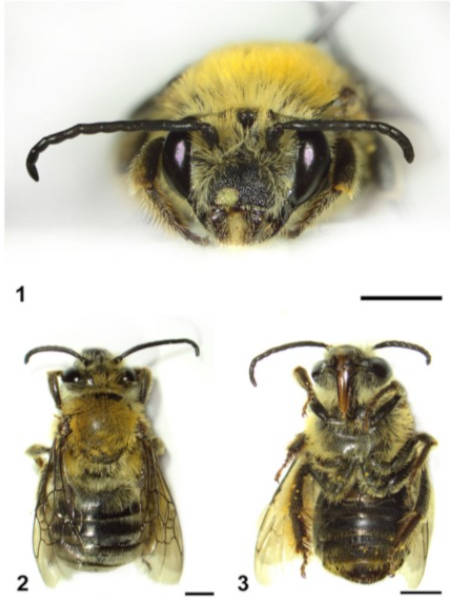By Laura Jones and Shelby Kilpatrick et.al
I visit pumpkin farms across Pennsylvania to investigate host-pathogen dynamics in bee communities. In pumpkin fields, we typically see three bee species foraging—honey bees, wild bumble bees, and wild squash bees.
Haven't heard of squash bees before? These are incredibly important, solitary bees that specialize in the pollen of pumpkin and squash. In fact, they are some of the best pollinators for pumpkin crops in Pennsylvania! Unlike social honey bees and bumble bees where only females bring food back to the hive, both male and female squash bees forage on flowers for nectar, and the females collect pollen for their offspring. Female and male squash bees also behave differently; the females spend much of their time collecting pollen to bring back to their nests, whereas the males frequent many flowers during the morning in search of females and occasionally nectar. Because of these sex-specific behaviors, identifying squash bees by sex is critical to understanding their independent roles in host-pathogen dynamics. However, last year I learned that this isn’t always as simple as it seems.
Squash bees live by the motto, "the early bee gets the nectar," often starting their day well before sunrise. In order to study them, we have to live by a similar motto, "the early researcher gets the bee." On one particular day, my labmate Ginamaría Roman-Echevarría and I drove to Butler, PA, starting our journey as usual, at about 3:00 a.m. In fact, everything about the start to our day was as it usually was: we drank too much coffee, sang along to our fieldwork playlist, and then collected bees in the all-too-cold morning weather.

Laura Jones collecting squash bees in the early morning.
When collecting squash bees, we try to confirm their sex from a few key characters. The males have long antennae and a yellow spot on their faces. The females have bushy hind legs covered in long setae that they use to transport pollen back to their nests. When in the flower, we identify these busy mothers quickly since their legs look enlarged and bright yellow from the pollen they've collected. I remember finding one such female, though strangely, only one leg looked pollen-ified. I noticed she was indeed collecting pollen, even if only successfully on one leg, so I scooped her up and labeled her as female. When we were satisfied with the day's haul we drove back to the lab. The hard part was over, or so we thought.
At the lab, I first confirm our field identifications before determining pathogen loads. When going through the bees to confirm their identifications this particular day, I noticed something strange. One female-labeled bee, the inefficient pollen-collector, had a long antenna. Then I noticed, she had a yellow spot on one side of her face. Lastly, I realized I had unfairly judged her pollen-packing abilities in the field – her left leg didn't have the long setae it needed to hold pollen! What I was looking at was a half-lady, half-gentleman! Her head was split as left-female, right-male, yet her body was split right-female, left-male. We had found a mosaic gynandromorph, where male and female characters are patchily distributed throughout the body.
These bees are very rare to find in the field and the mechanisms that lead to their development are not well known. In other organisms, gynanders can develop due to external stressors such as pollution, or even parasitism! We may never know what caused this particular bee to develop into a gynandromorph. However, we hope that with more documentation of these individuals in wild systems, we may be able to capture the frequency of their occurrence, and potentially identify what stressors may result in their development.
To learn more about this particular specimen or the potential developmental and environmental mechanisms of gynandromorphism in insects, check out our article in the Journal of Melittology:
Gynandromorph of the squash bee Eucera (Peponapis) pruinosa (Hymenoptera: Apidae: Eucerini) from an agricultural field in western Pennsylvania, USA

Figures 1–3. Mosaic gynandromorph of Eucera (Peponapis) pruinosa (Say); scale bars = 2 mm. 1. Head (in frontal view) showing the distinct bilateral split between the sexes (right half female, left half male). 2. Dorsal habitus showing male and female antennae, mesosoma, and female- like metasomal features. 3. Ventral habitus showing patchily distributed female and male fea- tures on the head and mesosoma, including the antennae and legs, and female-like metasoma.
Source : psu.edu